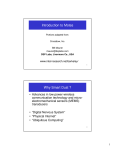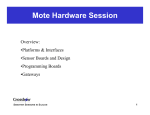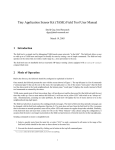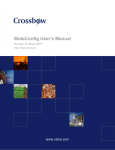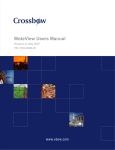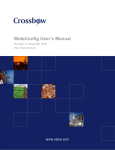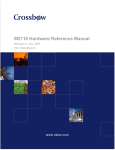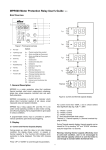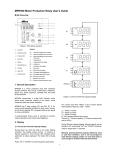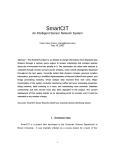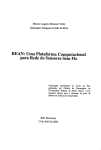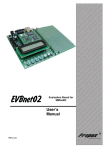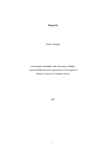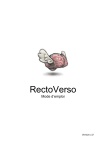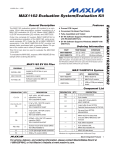Download MIB510 Programming Board
Transcript
MPR - Mote Processor Radio Board MIB - Mote Interface / Programming Board User’s Manual MPR500CA, MPR510CA, MPR520CA MPR400CB, MPR410CB, MPR420CB MPR300CA, MPR310CA MIB300CA, MIB500CA MIB510CA, MIB600CA Rev. A, December 2003 Document 7430-0021-05 Crossbow Technology, Inc., 41 Daggett Dr., San Jose, CA 95134 Tel: 408-965-3300, Fax: 408-324-4840 email: [email protected], website: www.xbow.com ©2002-2004 Crossbow Technology, Inc. All rights reserved. Information in this document is subject to change without notice. Crossbow and SoftSensor are registered trademarks and DMU is a trademark of Crossbow Technology, Inc. Other product and trade names are trademarks or registered trademarks of their respective holders. MPR/MIB Mote User Manual 1 Introduction.........................................................................4 2 MPR400/MPR410/MPR420 (MICA2)..................................5 2.1 2.1.1 Battery Operation..............................................................................5 2.1.2 External Power ..................................................................................7 2.2 3 4 Powering the mote ..................................................................................5 Radio/Antenna Considerations .............................................................7 2.2.1 Radio Transmission Power ...............................................................7 2.2.2 Antennas ..........................................................................................10 2.2.3 Connectors for the MICA2 and Whip Antennas..............................11 2.3 Data Logger and Other Features.........................................................13 2.4 Battery Voltage Monitor......................................................................13 2.5 Atmega128 Fuses..................................................................................13 2.5.1 Atmega103 compatibility mode fuse................................................14 2.5.2 JTAG fuse........................................................................................14 2.5.3 Using UISP to set fuses ...................................................................14 2.6 Sensor Boards........................................................................................14 2.7 Expansion Connector............................................................................15 MPR500/MPR510/MPR520 (MICA2DOT)........................16 3.1 Powering the Mote................................................................................16 3.2 Radio/Antenna Considerations ...........................................................16 3.3 Data Logger............................................................................................17 3.4 Battery Voltage Monitor......................................................................17 3.5 Atmega128 Fuses..................................................................................18 3.6 On-board Thermistor............................................................................18 3.7 Sensor Boards........................................................................................18 3.8 Expansion Connector............................................................................18 MPR300/MPR310 (MICA).................................................20 4.1 Powering the mote ................................................................................20 4.2 Radio/Antennae.....................................................................................20 Doc. # 7430-0021-05 Rev. A Page 1 MPR/MIB Mote User’s Manual 5 6 7 4.3 Data Logger............................................................................................20 4.4 Expansion Connector............................................................................20 4.5 Schematic ...............................................................................................21 MIB300 / MIB500 Interface Boards ...................................22 5.1 Programming the mote.........................................................................22 5.2 RS-232 Interface....................................................................................22 MIB510 Serial Interface Boards.........................................23 6.1 Programming the mote.........................................................................23 6.2 ISP............................................................................................................23 6.3 Device programming using MIB510 .................................................24 6.4 MICA2 and MICA2DOT connectors ................................................24 6.4.1 Reset ................................................................................................25 6.4.2 JTAG................................................................................................25 6.4.3 Power...............................................................................................25 6.4.4 RS-232 Interface..............................................................................25 MIB600CA.........................................................................26 7.1 Introduction............................................................................................26 7.1.1 Mote Network – Ethernet Gateway .................................................26 7.1.2 Mote Network Programming and Out-Band Diagnostic Channel ..27 7.2 Setup / Installation ................................................................................27 7.2.1 Physical...........................................................................................27 7.2.2 MICA Mote Connection ...................................................................27 7.2.3 Power...............................................................................................27 7.2.4 MIB600–LAN Connection ...............................................................28 7.3 7.3.1 7.4 Host Software ........................................................................................28 UISP................................................................................................28 MIB600 Use...........................................................................................29 7.4.1 Controls and Indicators...................................................................29 7.4.2 Mote UART (Serial Port) ................................................................30 Page 2 Doc. # 7430-0021-05 Rev. A MPR/MIB Mote User Manual 7.4.3 7.5 8 In-System Programming..................................................................30 JTAG.......................................................................................................31 Schematics .........................................................................34 8.1 MPR400/410/420, MICA2 Schematics.............................................34 8.2 MPR500/510/520 MICA2DOT Schematics.....................................39 8.3 MIB500 Schematic ...............................................................................43 9 Warranty and Support Information...................................48 9.1 Customer Service ..................................................................................48 9.2 Contact Directory ..................................................................................48 9.3 Return Procedure...................................................................................48 9.3.1 Authorization ...................................................................................48 9.3.2 Identification and Protection...........................................................50 9.3.3 Sealing the Container ......................................................................50 9.3.4 Marking...........................................................................................50 9.3.5 Return Shipping Address.................................................................50 9.4 10 Warranty.................................................................................................50 Appendix A: 10/100 Base-T Cabling Standards ..............51 Doc. # 7430-0021-05 Rev. A Page 3 MPR/MIB Mote User’s Manual 1 Introduction This User’s Manual describes the hardware features of the mote ProcessorRadio (MPR) wireless nodes . Currently, Crossbow sells three main varieties: MICA, MICA2, and MICA2DOT motes. It is intended for understanding and leveraging the mote hardware design in real-world sensor network applications. This User’s Manual also describes and explains the mote Interface Boards (MIB) for base station and programming requirements. This manual is not a software guide to programming the motes in TinyOS/nesC, nor is it a guide to pre-built software packages that run on top of the motes. The following two resources are available regarding software: • TinyOS Getting Started Guide (Document 7430-0022-03) by Crossbow Technology, Inc. • http://webs.cs.berkeley.edu/tos Mote Hardware Platform Models (as of Nov. 2003) MICA2 MPR400/410/420 MICA2DOT MPR500/510/520 MICA MPR300/310 10-Bit ADC ü ü ü Digital I/O ü ü ü UART ü LEDs 3 ü 1 3 ü AM Radio ü ü 916/433/315 916/433/315 916/433 Flash Data Logger Memory ü ü ü Antenna Connector ü FM Tunable Radio Base Radio Frequency (MHz) 3.3V Booster Page 4 ü Doc. # 7430-0021-05 Rev. A MPR/MIB Mote User Manual 2 MPR400/MPR410/MPR420 (MICA2) The MPR400 (916 MHz), MPR410 (433 MHz), and MPR420 (315 MHz) Series hardware is Crossbow’s latest generation of mote technology. All models utilize a powerful Atmega128L micro -controller and a frequency tunable radio with extended range. The MPR4X0 and MPR5X0 radios are compatible and can communicate with each other. Atmel® ATMega128 MMCX connector (female) External power connector On/Off Switch 51-pin Hirose connector (male) Figure 2-1. Photo of a MICA2 (MPR4X0) without an antenna 2.1 Powering the mote 2.1.1 Battery Operation The MPR400 is battery powered. The form factor of the MPR400 was designed to match up with two AA batteries; however any battery combination (AAA, C, D, etc., cells) can be used provided that the output is between 2.7– 3.3VDC. Care should be used in selecting the battery and its capacity to match the energy needs of the motes and their required operating span. Also make sure that the temperature range and associated capacity degradation are looked at prior to deployment. Table II-1 below provides some useful guidance on how to predict battery life. The spreadsheet can be found at http://www.xbow.comunder the Support section. Doc. # 7430-0021-05 Rev. A Page 5 MPR/MIB Mote User’s Manual Table 2-1. Battery Lifetime Estimates SYSTEM SPECIFICATIONS Currents Example Duty Cycle Processor current (full operation) 8 mA 1 current sleep 8 uA 99 8 mA 0.75 12 mA 0.25 2 uA 99 write 15 mA 0 read 4 mA 0 sleep 2 uA 100 Radio current in receive current transmit current sleep Logger Memory Sensor Board current (full operation) 5 mA 1 current sleep 5 uA 99 Computed mA-hr used each hour Processor 0.0879 Radio 0.0920 Logger Memory 0.0020 Sensor Board 0.0550 Total current (mA-hr) used 0.2369 Computed battery life vs. battery size Battery Capacity (mA-hr) Battery Life (months) 250 1.45 1000 5.78 3000 17.35 X NOTE: In most mote applications, the processor and radio run for a brief period of time, followed by a sleep cycle. During sleep, current consumption is in the micro-amps as opposed to milli-amps . This results in very lowcurrent draw the majority of the time, and short duration spikes while processing, receiving, and transmitting data. This method extends battery life; however, due to the current surges, it reduces specified battery capacity. Battery capacity is typically specified by the manufacturer for a constant nominal current drawn . Page 6 Doc. # 7430-0021-05 Rev. A MPR/MIB Mote User Manual 2.1.2 External Power The MICA2 can be externally powered through either: 1. 2. 2.2 The 51-pin connector will supply power and ground to the unit. Refer to connector des cription. The 2 pin Molex connector. Molex part number 53261-0290, DigiKey part number WM1753-ND. Radio/Antenna Considerations The radio on the MICA2 is capable of multiple channel operation, within the intended band of operation. The MPR420 can span up to 4 channels of operation in the 315 MHz band, the MPR410 can span up to 4 channels of operation in the 433 MHz band (433.05–434.79 MHz). The MPR400 can operate in two frequency regions: 868–870 MHz (up to 4 channels) and 902–928 MHz (up to 54 channels ). The actual number of possible channels is higher for all the MICA2 motes. However, it is recommended that the adjacent channel spacing should be at least 500 kHz to avoid adjacent channel interference thereby reducing the number of available channels . A tutorial on how to change frequency is available at http://www.tinyos.net/tinyos-1.x/doc/mica2radio/CC1000.html . 2.2.1 Radio Transmission Power The radio on the MICA2 can be adjusted for a range of output power levels. The register in the radio that controls the RF power level is designated PA_POW at address 0x0B, and the values and their corresponding RF outputs are provided on Table 2-2 below. It shows the closest programmable value for output powers in steps of 1 dBm. For power down mode the Chipcon datasheet says, “the PA_POW should be set to 00h [0x00] for minimum leakage current.” Doc. # 7430-0021-05 Rev. A Page 7 MPR/MIB Mote User’s Manual Table 2-2. Chipcon® CC1000 Ouput Power (PA_POW) Settings and Typical Current Consumption. From Smart RF® CC1000 Preliminary Datasheet (rev. 2.1), 2002-04-19, p. 29 of 48. Pout (dBm) PA_POW (hex) 433/315 MHz Current Consumption, typ. (mA) -20 -19 -18 -17 -16 -15 -14 -13 -12 -11 -10 -9 -8 -7 -6 -5 -4 -3 -2 -1 0 1 2 3 4 5 6 7 8 9 10 0x01 0x01 0x02 0x02 0x02 0x03 0x03 0x03 0x04 0x04 0x05 0x05 0x06 0x07 0x08 0x09 0x0a 0x0b 0x0c 0x0e 0x0f 0x40 0x50 0x50 0x60 0x70 0x80 0x90 0xc0 0xe0 0xff 5.3 6.9 7.1 7.1 7.1 7.4 7.4 7.4 7.6 7.6 7.9 7.9 8.2 8.4 8.7 8.9 9.4 9.6 9.7 10.2 10.4 11.8 12.8 12.8 13.8 14.8 15.8 16.8 20.0 22.1 26.7 PA_POW (hex) 915 MHz Current Consumption, typ. (mA) 0x02 0x02 0x03 0x03 0x04 0x05 0x05 0x06 0x07 0x08 0x09 0x0b 0x0c 0x0d 0x0f 0x40 0x50 0x50 0x60 0x70 0x80 0x90 0xb0 0xc0 0xf0 0xff 8.6 8.8 9.0 9.0 9.1 9.3 9.3 9.5 9.7 9.9 10.1 10.4 10.6 10.8 11.1 13.8 14.5 14.5 15.1 15.8 16.8 17.2 18.5 19.2 21.3 25.4 The radio on the MICA2 also provides a measurement of the received signal strength, referred to as RSSI. This output is measured on ADC channel 0 and is available to the software. Some versions of TinyOS Page 8 Doc. # 7430-0021-05 Rev. A MPR/MIB Mote User Manual provide this measurement automatically, and others must be enabled by the user. The conversion from ADC counts to RSSI in dBm is given by: VRSSI = Vbatt × ADC _ Counts 1024 RSSI (dBm ) = −51 .3 × V RSSI − 49 .2 for 433 and 315 MHz motes RSSI (dBm ) = −50. 0 × VRSSI − 45 .5 for 915 MHz motes Figure 2-2. Graph showing VRSSI versus the received signal strength indicator (dBm). From the ChipCon’s SmartRF® CC1000 PRELIMINARY Datasheet (rev. 2.1), p. 30. 2002. Care should be taken to provide an antenna that provides proper coverage for the environment expected. Range and performance are strongly affected by choice of antenna and antenna placement within the environment. In addition, care must be taken to ensure compliance with FCC article 15 regulations for intentional radiators. An omni directional antenna such as a quarter wavelength whip should be sufficient to meet most user requirements. M WARNING: The radio on the MICA2 has an extremely sensitive receiver, which can be interfered with by an adjacent local oscillator from another MICA2. A distance of at least 2 feet should be maintained between MICA2 units to avoid local oscillator interference. Doc. # 7430-0021-05 Rev. A Page 9 MPR/MIB Mote User’s Manual 2.2.2 Antennas Antenna lengths for three frequencies are provided Table 2 -3. The antennas available from Crossbow are the 8060-0010-0# and 8060-0011-0# solder and connectorized antennas, respectively. See Figures 2-4 and 2-5. Table 2-3. Antenna lengths for quarter wavelength whip antennas. Model MPR400 (916 MHz) MPR410 (433 MHz) MPR420 (315 MHz) Whip Antenna Length (inches) 3.2 6.8 9.4 Antennas are also available from Linx Technologies, such as part number ANT-433-PW-QW for 433 MHz and ANT-916-PW-QW for 916 M Hz. These antennas are terminated in a coax pigtail, and must have an MMCX connector installed. They also function best with a ground plane installed, as shown Figure 2-3 below. The ground plane can be a layer of aluminum or copper tape attached to the lid of a plastic enclosure, or the lid of a metal enclosure. NUT MAKES CONTACT WITH GROUND PLANE METALLIC GROUND PLANE 1/2 WAVELENGTH RECOMMENDED Figure 2-3. Illustration of an antenna option for the motes using a Linx antenna and ground plane Page 10 Doc. # 7430-0021-05 Rev. A MPR/MIB Mote User Manual 2.2.3 Connectors for the MICA2 and Whip Antennas The MICA2 has an MMCX connector for attaching an external antenna. These mating connectors can be purchased from Digi-Key. There are two manufacturers—Johnson Components and Hirose Electric Ltd. The mating connectors come in straight and right angle. They also support two different standard varieties of Coaxial cable—RG178 /U and RG 316/U. There are also other vendors who sell MMCX to SMA conversion cables. Table 2-4. Johnson Components’ MMCX mating connectors.* Type Coax Digi-Key PN Johnson PN Straight Plug RG178/U J589-ND 135-3402-001 Straight Plug RG316/U J590-ND 135-3403-001 Right Angle RG178/U J593-ND 135-3402-101 Right Angle RG316/U J594-ND 135-3403-101 Right Angle RG 316 DS J595-ND 135-3404-101 * These connectors require the following hand crimp and die set (Digi-Key part # / Johnson part #): a) Hand crimp (J572-ND / 140-0000-952), b) Die (JD604-ND / 140-0000-953). Table 2-5. Hirose MMCX connectors Type Coax Digi-Key PN Hirose PN Straight Plug RG178/U H3224-ND MMCX-J-178B/U Right Angle RG178/U H3221-ND MMCX-LP-178B/U Right Angle RG316/U H3222-ND MMCX-LP-316/U Doc. # 7430-0021-05 Rev. A Page 11 MPR/MIB Mote User’s Manual DATE BY DESCRIPTION ECO 5/13/03 M. GRIMMER REV A- MICA ANTENNA NEW RELEASE 0432 6/30/03 M. GRIMMER REV B- ADDED 315 MHZ ANTENNA 0521 LENGTH 0.080 0.25 IN. DIA. WIRE IS SOLID CONDUCTOR 20 AWG WITH BLACK INSULATION LENGTH FREQUENCY MODEL PART NUMBER 3.20 inches 915 MHz MPR400/MPR500 8060-0010-01 6.80 inches 433 MHz MPR410/MPR510 8060-0010-02 9.35 inches 315 MHz MPR420/MPR520 8060-0010-03 CROSSBOW TECHNOLOGY DATE BY 5/13/03 M. GRIMMER 8060-0010 DWG REV B MICA ANTENNA ASSY 5/13/03 PAGE 1 OF 1 Figure 2-4. Wire antenna w/o MMCX connector. Part nos. 8060-0010-0X LENGTH FREQUENCY DATE BY 5/13/03 M. GRIMMER REV A-MICA ANTENNA NEW RELEASE 0432 6/24/03 M. GRIMMER REV B-MODIFIED SHRINK TUBE LENGTH 0393 6/30/03 M. GRIMMER REV C-ADDED 315 MHZ ANTENNA 0521 MODEL DESCRIPTION PART NUMBER 3.20 inches 915 MHz MPR400 8060-0011-01 6.80 inches 433 MHz MPR410 8060-0011-02 9.35 inches 315 MHz MPR420 ECO 8060-0011-03 CROSSBOW TECHNOLOGY DATE BY 5/13/03 M. GRIMMER DWG REV C 8060-0011 MICA ANTENNA ASSY 5/13/03 PAGE 5 OF 5 Figure 2-5. Wire antenna with MMCX connector. Part nos. 8060-0011-0X Page 12 Doc. # 7430-0021-05 Rev. A MPR/MIB Mote User Manual 2.3 Data Logger and Other Features The MICA2 mote features a 4-Mbit serial flash for storing data, measurements, and other user-defined information. TinyOS supports a micro file system that runs on top of this flash/data logger component. The serial flash device supports over 100,000 measurement readings. Also on the MICA2 is a 64-bit serial ID chip. X NOTE: This device consumes 15 mA of current when writing data. 2.4 Battery Voltage Monitor The MICA2 has an accurate voltage reference that can be used to measure battery voltage (Vbatt). Since the eight-channel, Atmega128 ADC uses the battery voltage as a full scale reference, the ADC full scale voltage value changes as the battery voltage changes. In order to calibrate the battery voltage a precision external voltage reference is required. The MICA2 uses an LM4041, 1.223 volt reference (Vref ) attached to ADC channel 7. X NOTE: ADC channel 7 is also used for JTAG debugging on the Atmega128 processor. MICA2s and MICA2DOTs ship with the JTAG fuse enabled. When this fuse is enabled the input impedance of channel 7 is lowered which affects the voltage reference measurement. The fuse should be disabled if ADC channel 7 is used. See below for information on setting Atmega128 fuses. To compute the battery voltage: 1. Set the BAT_MON processor pin (PA5/AD5) high. 2. Program the application code to measure ADC channel 7. 3. Compute battery voltage, Vbatt, from channel 7’s data by: Vbatt = Vref × ADC _ FS ADC _ Count where: Vbatt = Battery voltage ADC_FS = 1024 Vref = External voltage reference = 1.223 volts ADC_Count = Data from the ADC measurement of channel 7 2.5 Atmega128 Fuses The Atmega128 processor on the MICA2 has many programmable fuses to control various parameters. Refer to Atmel’s technical information for the Atmega128 for a complete discussion of the fuses Doc. # 7430-0021-05 Rev. A Page 13 MPR/MIB Mote User’s Manual (http://www.atmel.com/dyn/resources/prod_documents/2467s.pdf). There are two fuses that TOS users should be aware of as setting these fuses incorrectly will cause the unit to not operate correctly. 2.5.1 Atmega103 compatibility mode fuse This fuse put the Atmega128 in the Atmega103 compatible mode. This fuse was set for the older generation MICA units. It must be disabled for MICA2 and MICA2DOTs. 2.5.2 JTAG fuse This fuse enables users to use the Atmel JTAG pod for in-circuit code debugging. Units are shipped with JTAG enabled. As discussed in the previous section on battery voltage monitoring, if JTAG is enabled, it will cause inaccurate measurements on ADC channel 7. 2.5.3 Using UISP to set fuses The UISP utility used to download code to the MICA2 on a programming board can also be used to set and unset fuses of the Atmel® ATMega128. Table 2-6. UISP Commands for Setting the ATMega128’s Fuses Action Disable JTAG fuse Enable JTAG fuse Enable native 128 mode Command uisp -dprog=<programmer>* --wr_fuse_h=0xD9 uisp -dprog=<programmer> --wr_fuse_h=0x19 uisp -dprog=<programmer> --wr_fuse_e=ff * <programmer> is the device you are using to interface to the mote from a computer. The current options are dapa (for an MIB500), dev/ttyS<#> for an MIB510 (<#> = 0 for COM1, 1 for COM1, 2 for COM3, etc.), and AVRSP for an AVRSP and EPRB for an EPRB. Users can also edit the filed called profile in the cygwin/etc directory and enter an alias. One example is this alias to disable the JTAG fuse: alias fuse_dis="uisp -dprog=<programmer> --wr_fuse_h=0xD9" When fuse_dis is typed from a Cygwin command line, the script will be executed. 2.6 Sensor Boards Crossbow supplies a variety of sensor boards for the MICA2s. Information for customized sensor board design is available on the Crossbow web site. Page 14 Doc. # 7430-0021-05 Rev. A MPR/MIB Mote User Manual 2.7 Expansion Connector The expansion connector provides a user interface for additional sensor boards. The connector includes interfaces for power and ground, power control of peripheral sensors, ADC inputs for reading sensor outputs, a UART interface, and I2C interface, general-purpose digital IO, and others. Table 2-7. MICA2 Sensor Interface Pin Name Description Pin Name Description 1 2 3 4 5 6 GND VSNR INT3 INT2 INT1 INT0 27… 28… 29 30 31 32 UART_RXDO UART_TXDO PWO PW1 PW2 PW3 Uart Receive Uart Transmit GPIO/PWM GPIO/PWM GPIO/PWM GPIO/PWM 7… BAT_MON 33 PW4 GPIO/PWM 34 35 PW5 PW6 36… ADC7 … GPIO/PWM GPIO/PWM GPIO/ADC CH7, JTAG GPIO/ADC CH6, JTAG … 8 9… LED3 LED2 Ground Voltage (battery GPIO GPIO GPIO GPIO Battery Voltage Monitor Green LED Yellow LED 10… LED1 Red LED 11 RD GPIO 37 ADC6 12 WR GPIO 38… ADC5 13 ALE GPIO 39… ADC4 GPIO Usart Clock Programmer Pin Programmer Pin Radio Clock Usart1 Receive Usart1 Transmit I2C Bus Clock I2C Bus Clock GPIO GPIO GPIO GPIO functionality 40 41 42 43 44 45 46 47 48…… 49 50 51 ADC3 ADC2 ADC1 ADC0 THERM_PWR THRU1 THRU2 THRU3 RSTN PWM1B VCC GND 14 PW7 15 USART_CLK 16…… PROG_MOSI 17…… PROG_MISO 18…… SPI_CLK 19 USART1_RXD 20 USART1_TXD 21 I2C_CLK 22 I2C_DATA 23 PWMIO 24 PWMIA 25 AC+ 26 AC… OK to use but has shared …… Do NOT use. 26 GPIO/ACD CH5, JTAG GPIO/ADC CH4, JTAG GPIO/ADC CH3 GPIO/ADC CH2 GPIO/ADC CH1 GPIO/ADC CH0 GPIO Thru User Connect Thru User Connect Thru User Connect Micro Processor Reset GPIO Voltage (battery) Ground 1 26 1 27 27 51 51 Figure 2-0-1. Hirose DF-9(S on left; P on right)-1V(54) Doc. # 7430-0021-05 Rev. A Page 15 MPR/MIB Mote User’s Manual 3 3.1 MPR500/MPR510/MPR520 (MICA2DOT) Powering the Mote The MPR500 (916 MHz), MPR510 (433 MHz), and MPR520 (315 MHz) are battery powered. The form factor of the MPR500 was designed to match up with a single coin cell battery; however any battery combination (AAA, C, D, etc., cells) can be used provided that the output is between 2.7– 3.3VDC. Atmel® ATMega128 (a) Top-side Chipcon® CC1000 (b) Bottom-side Figure 3-1. Photos of the MICA2DOT shown next to a US quarter: a) Top-side and b) Bottom-side . Typically the MICA2DOT has a 3V coin-cell battery holder attached to the bottom-side, but it has been removed to show the details. Care should be used in selecting the battery and its capacity to match the energy needs of the motes and their deployment mission. Also make sure that the temperature range and associated capacity degradation are looked at prior to deployment. The section below provides some useful guidance on how to predict battery life. The spreadsheet can be found at http://www.xbow.comunder the Support section. 3.2 Radio/Antenna Considerations Care should be taken to provide an antenna that provides proper coverage for the environment expected. Range and performance are strongly affected by choice of antenna and antenna placement within the environment. In Page 16 Doc. # 7430-0021-05 Rev. A MPR/MIB Mote User Manual addition, care must be taken to ensure compliance with FCC article 15 regulations for intentional radiators. Because of its small physical size, the usual antenna chosen is a length of insulated wire one-quarter wavelength long for the frequency of interest (˜ 3.2 inches at 915 MHz, ˜ 6.8 inches at 433 MHz, and ˜ 9.4 inches at 315 MHz). (For information about the number of channels for each type of MICA2DOT, please refer to Section 2.2. Table 3-1. Antenna lengths for quarter wavelength whip antennas 3.3 Model Whip Antenna Length (inches) MPR500 (916 MHz) 3.2 MPR510 (433 MHz) 6.8 MPR520 (315 MHz) 9.4 Data Logger The MICA2DOT mote features a 4-Mbit serial flash (non-volatile) memory for storing data, measurements, and other user-defined information. TinyOS supports a micro file system that runs on top of this flash/data logger component. The serial flash device supports over 100,000 measurement readings. X NOTE: This device consumes 15 mA of current when writing data. 3.4 Battery Voltage Monitor Unlike the MICA2, the MICA2DOT uses a Schottky reference diode as a voltage reference that can be used to measure battery voltage (Vbatt). Since the eight-channel, Atmega128 ADC uses the battery voltage as a full-scale reference, the ADC full scale voltage value changes as the battery voltage changes. In order to calibrate the battery voltage an external voltage reference (Vref) is required. To compute the battery voltage: 1. Set processor pins PW7 (PC7/A15) to LO and PW5 (PC5/A13) to HI. 2. Program the application code to measure ADC channel 1 (ADC1). 3. Compute battery voltage, Vbatt, from channel 1’s data by: Vbatt = Vref × ADC _ FS ADC _ Count where: Vbatt = Battery voltage ADC_FS = 1024 Doc. # 7430-0021-05 Rev. A Page 17 MPR/MIB Mote User’s Manual Vref = External voltage reference = 0.6 volts ADC_Count = Data from the ADC measurement of channel 1 3.5 Atmega128 Fuses Refer to the Atmega128 fuse section for the MICA2 product. 3.6 On-board Thermistor The MICA2DOT has an on board thermistor (Panasonic ERT-J1VR103J) which is a surface mount component. It is one the ATmega side of the board at the location labeled “RT1.” Its output is at ADC1 and is enabled by setting PW6 (PC6/A14) to LO and PW7 (PC7/A15) to HI. The mote’s ADC output can be converted to degrees Kelvin using the following approximation over 0–50 degrees Celsius: 1/T(K) = a + b × ln(Rthr) + c × [ln(Rthr)]3 where: Rthr = R1 × ADC/(ADC_FS–ADC) a = 0.00130705 b = 0.000214381 c = 0.000000093 R1 = 10 k? ADC_FS = 1023 ADC = output value from mote’s ADC measurement. 3.7 Sensor Boards Crossbow has a customizable, sensor prototyping board called the MDA500CA for the MICA2DOT. Information for customized sensor board design is available on the Crossbow web site. 3.8 Expansion Connector The interface to the MPR500 is through a series of 19 pins spaced around the circumference of the MPR500. They represent a subset of the pins available on the MPR400. They include a set of power control pins, ADC channels, power, ground, some general purpose digital IO, and the serial programming port. For applications with more digital IO, the ADC pins can be reconfigured as digital input/output but not both. Page 18 Doc. # 7430-0021-05 Rev. A MPR/MIB Mote User Manual M WARNING: The TP12 SPI_CK Pin is controlled by the Radio. In the majority of applications it should not be used. It is also used for programming the processor. Pin Name Description TP1 TP2 TP3 TP4 TP5 TP6 TP7 TP8 TP9 TP10 TP11 TP12 TP13 TP14 TP15 TP18 TP19 TP20 TP21 GND ADC7 ADC6 ADC5 ADC4 VCC PW1 PW0 UART_TXD UART_RXD RESETN SPI_CLK ADC3 ADC2 PWM1B GND INT0 INT1 THERM_PWR Ground ADC Channel 7 ADC Channel 6 ADC Channel 5 ADC Channel 5 Voltage (battery) GPIO/PWM GPIO/PWM UART Transmit UART Receive µProcessor Reset Radio Clock ADC Channel 3 ADC Channel 2 GPIO Ground GPIO GPIO GPIO Figure 3-2. MICA2DOT Pin Diagram and Sensor Interface Description Doc. # 7430-0021-05 Rev. A Page 19 MPR/MIB Mote User’s Manual 4 4.1 MPR300/MPR310 (MICA) Powering the mote The MPR300/MPR310 is battery powered. The form factor of the MPR300 was designed to match up with two AA batteries; however any battery combination (AAA, C, D, etc., cells) can be used provided that the output is between 2.7– 3.3VDC. Care should be used in selecting the battery and its capacity to match the energy needs of the motes and their deployment mission. Also make sure that the temperature range and associated capacity degradation are looked at prior to deployment. The section below provides some useful guidance on how to predict battery life. The spreadsheet can be found at http://www.xbow.comunder the Support section. 4.2 Radio/Antennae Care should be taken to provide an antenna that provides proper coverage for the environment expected. Range and performance are strongly affected by choice of antenna and antenna placement within the environment. In addition, care must be taken to ensure compliance with FCC article 15 regulations for intentional radiators. Because of its small physical size, the usual antenna chosen is a length of insulated wire one-quarter wavelength long for the frequency of interest (~3.5 inches at 915 MHz, and ~8 inches at 433 MHz). 4.3 Data Logger The MICA mote features a 4-Mbit serial flash (non-volatile) memory for storing data, measurements, and other user-defined information. TinyOS supports a micro file system that runs on top of this flash/data logger component. The serial flash device supports over 100,000 measurement readings. Also on the MICA is a 64-bit serial ID chip. X NOTE: This device consumes 15 mA of current when writing data. 4.4 Expansion Connector The expansion connector provides a user interface for additional sensor boards. The connector includes interfaces for power and ground, power control of peripheral sensors, ADC inputs for reading sensor outputs, a UART interface, and I2C interface, general purpose digital IO, and others. Page 20 Doc. # 7430-0021-05 Rev. A MPR/MIB Mote User Manual PIN 1 2 3 4 5 6 7 8 9 10 11 12 13 14 15 16 17 18 19 20 21 22 23 24 25 26 4.5 DESCRIPTION GND VDD_ANALOG INT3 INT2 INT1 INT0 DC_BOOST_SHDN LED3 LED2 LED1 RD WR ALE PW7 FLASH_CLK UART_RXD0 UART_TXD0 SPI_CLK FLASH_SO FLASH_SI I2C_BUS1_CLK I2C_BUS1_DATA PWM0 PWM1A AC+ AC- PIN 27 28 29 30 31 32 33 34 35 36 37 38 39 40 41 42 43 44 45 46 47 48 49 50 51 DESCRIPTION UART_RXD0 UART_TXD0 PW0 PW1 PW2 PW3 PW4 PW5 PW6 ADC7 ADC6 ADC5 ADC4 ADC3 ADC2 ADC1 ADC0 LITTLE_GUY_RST LITTLE_GUY_SPI_CLK LITTLE_GUY_MISO UART_RXD0 RESET PWM1B VCC GND Schematic Schematics for this mote design are found at: http://today.cs.berkeley.edu/tos/hardware/hardware.html Doc. # 7430-0021-05 Rev. A Page 21 MPR/MIB Mote User’s Manual 5 MIB300 / MIB500 Interface Boards M WARNING: When programming a MICA2 with the MIB500, turn off the battery switch. For a MICA2DOT, remove the battery before inserting into the MIB500. The MICA2s and MICA2DOTs do not have switching diodes to switch between external and battery power. 5.1 Programming the mote The MIB300/MIB500 interface boards are multi-purpose interface boards used in conjunction with the MICA Family of products. They supply power to the devices through an external power adapter option, and provide interfaces for an RS232 serial port and reprogramming port (using the parallel printer interface). The MIB300 can only be used with an external 3 VDC supply, or it can take advantage of the battery power supplied from the mote. The MIB500 has an on-board regulator that will accept 5 to 7 VDC, and supplies a regulated 3 VDC to the MICA The MIB500 is delivered with a wall power supply. It also has a monitor LEDs that mirror the LEDs on the MICA. There is a built-in low voltage monitor that disables reprogramming if the power supply voltage is dangerously low. When the proper programming voltage exists—the Green LED adjacent the paralle l port is lit—D6. If the voltage goes below 2.95V, the Green LED D6 will turn off, programming is disabled. The MIB500 also has an interface connector for reprogramming the MICA2DOT. Programming the mote is accomplished by connecting the MIB300/MIB500 to the parallel port of the computer, and executing the required programming software—UISP—supplied with the TinyOS install. X NOTE: There have been numerous reported difficulties with programming motes through the MIB500CA. These include program failure, flash verification errors, and dead motes. The root cause of these problems is almost always one of two issues: 1) low programming voltage or 2) UISP problems on the Host PC. A detailed application note is posted at http://www.xbow.com under Support. Please review this application note, if you have trouble programming. Programming the motes improperly or with a bad UISP install can result in permanent damage to the mote CPU. 5.2 RS-232 Interface The RS-232 interface is a standard single channel bi-directional interface with a DB9 connector to interface to an external computer. It uses transmit and receive lines only. Page 22 Doc. # 7430-0021-05 Rev. A MPR/MIB Mote User Manual 6 MIB510 Serial Interface Boards X NOTE: The MIB510 will only work with Atmega128 processors used on the MIC2 and MICA2DOT. It will work for older mica units that have the Atmega128 processor but not earlier processors such as the Atmega103. 6.1 Programming the mote The MIB510 interface board is a multi-purpose interface board used with the MICA2 and MICA2DOT family of products. It supplies power to the devices through an external power adapter option, and provides an interface for a RS-232 mote serial port and reprogramming port. Reset Switch Enable/Disable Mote Tx Switch AC Wall-Power Connector RS-232 Serial Port (DB9 female) ISP leds MICA2 connector MICA2DOT connector Mote JTAG connector Fig 6.1 Photo of top view of an MIB510CA 6.2 ISP The MIB510 has an on-board in-system processor (ISP) to program the motes. Code is downloaded to the ISP, over the serial port, and the ISP programs the code into the mote. The ISP and mote share the same serial port. The ISP runs at a fixed baud rate of 115 kbaud. The ISP continually monitors incoming serial packets for a special multi-byte pattern. Once this pattern is detected it disables the mote’s serial Rx and Tx, then takes control of the serial port. M WARNING: Some USB to DB9 serial port adapters cannot run at 115 kbaud. Doc. # 7430-0021-05 Rev. A Page 23 MPR/MIB Mote User’s Manual The ISP processor has two LEDs, ‘SP PWR’ (green) and ISP (red). SP PWR is used to indicate the power state of the MIB510 (see below). If the ISP led is on, the MIB510 has control of the serial port. It will blink when the RESET button is activated. 6.3 Device programming using MIB510 To program motes with MIB510 you precede all downloading commands with MIB510=/dev/<port> where <port> is the name of the serial port where the device is attached. (If using a USB to DB9 serial port converter, you need to know which COM number it assigned to the converter device.) For example: $ MIB510=/dev/ttyS0 make (re)install <hardware> assuming the serial port you’re using is COM1. Otherwise it is ttyS1 for COM2, ttyS2 for COM3, ttyS3 for COM4, etc. Using the standard commands (e.g. make mica install) will default to the MIB500 programme r board. <hardware> will either be mica2 or mica2dot. To save keystrokes during programming, you can create (or edit) a Makelocal file in your apps directory. To make the MIB510 the default programmer, add the following line in Makelocal. MIB510=/dev/ttyS<#> Again the “<#>” refers to the number your computer assigned to the standard COM port or the assigned port number for users of a USB to DB9 serial port converter. Please refer to http://www.tinyos.net/tinyos1.x/doc/tutorial/buildenv.html for more details on creating and editing a Makelocal file. M WARNING: Under cygwin the ISP may not get control of the serial port if the mote is continually sending packets over the serial Tx line at a high rate. If this happens uisp will hang. This can be fixed by: 1. Type Cntrl C and try again. 2. Turn SW2 to the ‘on’ position. This will disable the mote’s Tx line. Be sure to set SW2 to ‘off’ after programming the mote if you are using the mote as a base station (ex: GenericBase). 6.4 MICA2 and MICA2DOT connectors The MIB510 has connectors for both the MICA2 and MICA2DOT. See the picture below. For the MICA2 there is another connector on the bottom side Page 24 Doc. # 7430-0021-05 Rev. A MPR/MIB Mote User Manual of the MIB510 for sensor boards. MICA2DOTs with battery connectors can be mounted, also, to the bottom side of the board. 6.4.1 Reset The RST MOTE switch resets both the ISP and mote processors. RST resets the ISP; after the ISP powers-up it resets the mote’s processor. 6.4.2 JTAG The MIB510 has a connector, J3 (MOTE JTAG) which connects to an Atmel JTAG pod for in-circuit debugging. This connector will supply power to the JTAG pod; no external power supply is required for the pod. M WARNING: The MIB510 also has JTAG and ISP connectors for the ISP processor. These are for factory use only. 6.4.3 Power The MIB510 has an on-board regulator that will accept 5 to 7 VDC, and supply a regulated 3V to the MICA. The MIB510 is delivered with a wall power supply. M WARNING: Applying more than 7 VDC will damage the onboard linear regulator. There is a built-in low voltage monitor that disables reprogramming if the power supply voltage is dangerously low. When the proper programming voltage exists the ISP PWR led is on. If the voltage goes below 2.9 V, the ISP PWR led will blink and disable the mote from any code downloads. If the voltage is too low to power the ISP then the ISP PWR led will be off. M WARNING: When programming a MICA2 with the MIB510, turn off the battery switch. For a MICA2DOT, remove the battery before inserting into the MIB510. The MICA2s and MICA2DOTs do not have switching diodes to switch between external and battery power. 6.4.4 RS-232 Interface The RS-232 interface is a standard single channel bi-directional interface with a DB9 connector to interface to an external computer. It uses the transmit and receive lines only. Doc. # 7430-0021-05 Rev. A Page 25 MPR/MIB Mote User’s Manual 7 7.1 MIB600CA Introduction The MIB600CA provides Ethernet (10/100 Base-T) connectivity to MICA2 family motes for communication and in-system programming. Its two standard configurations are a) an Ethernet Gateway for a mote network and b) a mote network programming and out-band diagnostic channel. The MIB600CA device contains, on a 4.5” × 2.25” platform a • MICA2 mote 54-pin connector (J1), • Mote umbilical connector (J11), • Mote target JTAG port (J12), • TCP/IP serial server, • In-system programmer compatible with UISP STK500, • On-board power regulation and monitor, and a • Power Over Ethernet (POE) power supply Ext 5V / POE Power Select MIB600 & Mote Reset Switch J12: Mote JTAG port J11: Mote Umbilical Connector External 5V DC Power Connector Figure 7-1. Photo of top side of an MIB600CA. 7.1.1 Mote Network – Ethernet Gateway A MICA2 mote running TOSBase or GenericBase is permanently installed on the MIB600. This forms a mote RF to Ethernet bridge. Page 26 Doc. # 7430-0021-05 Rev. A MPR/MIB Mote User Manual 7.1.2 Mote Network Programming and Out-Band Diagnostic Channel MICA2 connect to the MIB600 for UISP programming from LAN connected host computers. Out band (non-RF) diagnostics can be forwarded from the mote via its UART port over the LAN to host monitor/control computers. 7.2 Setup / Installation This section describes MIB600 installation and configuration for use in a TinyOS v1.1 environment. 7.2.1 Physical For other than temporary installations, the MIB600 should be installed in a ground isolated enclosure. 7.2.2 MICA Mote Connection MICA and MICA2 motes connect to the MIB600 directly via the standard mote 51-pin HIROSE connector at J1. Two mounting holes are provided for securing the MICA2 mote when installed at J1. It is recommended that these mounting points be used to ensure a reliable mechanical and electrical connection to the MIB600. 7.2.3 Power Two power supply sources are available with the MIB600 • • External 5VDC from AC wall-powe r adaptor Power Over Ethernet External 5VDC Power Supply • Connect the external 5VDC power supply to an AC 110-240V power source. • Place the MIB600 SW2 in the POE position Connect the DC plug to J7 of the MIB600 • X NOTE Turn-on the MIB by placing the SW2 in the 5V position. Turn-off by placing the SW2 in the POE position. Power Over Ethernet / IEEE802.3af (POE). M WARNING! The MOTE “ground” is at POE potential (-48V). DO NOT connect MIB600 to facility/building ground when using POE. Doc. # 7430-0021-05 Rev. A Page 27 MPR/MIB Mote User’s Manual An IEEE 802.3af compliant power supply is provided for POE equipped facilities. Ethernet appliance power (-48 V) is supplied at pins 4/5 and 7/8 of the 10/100 Base-T RJ45 plug. Refer to Appendix A for Base-T wiring information. The MIB600 POE circuit contains IEEE 802.13f compliant power sequencing and classification circuitry. Reversed and over-voltage protection is provided. X NOTE: The MIB600 only supports POE over “spare wires 4/5 & 7/8”. It does NOT support POE shared on the Base-T signaling lines. • Connect the MIB600 to a POE-equipped LAN port. • Turn-On the MIB600 by placing the MIB600 SW2 in the POE position • Turn-Off by placing SW2 in 5V position (with External 5VDC supply disconnected) 7.2.4 MIB600–LAN Connection The MIB600 Serial Server connects directly to a 10 Base-T LAN as any other network device. Straight cables are used to connect to a hub or switch. If your connection is an MIB600 to PC you must use a crossed cable. Refer to Appendix A for LAN wiring information. Table 7-1. Pin Outs for a LAN Connection Pin No. Strand Color 1 Name TX+ 2 orange TX- 3 white and green RX+ 4 blue 0V POE 5 White and blue 0V POE 6 green RX- 7 8 7.3 white and orange Brown and white -48V POE Brown -48V POE Host Software 7.3.1 UISP UISP version 20030820tinyos or newer is required. This version is included in the TinyOS 1.1.0 September 2003 release package. Verify your system is using a compatible UISP version by entering uisp -–version in a Cygwin window (see the example below in Figure 7-2). Page 28 Doc. # 7430-0021-05 Rev. A MPR/MIB Mote User Manual Figure 7-2. Screen shot of the output after typing in uisp --version. 7.4 MIB600 Use 7.4.1 Controls and Indicators Power. MIB600 power (and power to attached mote) is controlled by the switch labeled “SW2.” M WARNING! Always turn-off the MIB600’s power before installing/removing a mote. Table 7-3. SW2 Switch Settings Position 5V POE Function External 5V DC power supply selected Power Over Ethernet supply selected When valid power is detected, the green LED at D5 is ON. LAN Activity Indicators (RJ45). Green indicates a network connection is present. Yellow indicates Active ISP serial port traffic is present. RESET. Pressing the RESET pushbutton (SW1) causes the MIB600 and any installed/attached MOTE to reset. Note the Serial Server is NOT reset. Serial Server RESET. Pressing the S1 switch on the server sub-module (U15) manually resets the Ethernet serial server. XNOTE The MIB600 and attached MOTE are NOT reset. The serial server can also be reset via Telnet at Port 9999. ISP LED. During in-system programming of a mote the ISP LED (D3) is ON. Mote LEDs. Three LEDs (red, green, yellow) correspond to the attached mote’s indicators. Doc. # 7430-0021-05 Rev. A Page 29 MPR/MIB Mote User’s Manual 7.4.2 Mote UART (Serial Port) The mote’s serial port can be accessed via Telnet using Port# 10002. Factory default serial rate on the Serial Server is 57.6 kbaud for compatibility with the standard TinyOS v1.1 release of TOSBase & GenericBase. If other baud rates or communication parameters are used in your mote application, the serial server configuration must be changed. 7.4.3 In-System Programming The MIB600 ISP micro-controller is attached to Port#10001. UISP assumes this port assignment by default. UISP at the Cygwin command line is the standard TinyOS programming tool. The MIB600 compatible command switches • -dprog=stk500 • -dhost=<IP address> • -dpart=Atmega128 can be added to the Makerules file under …/tinyos/apps. The command line is uisp –dprog=stk500 –dhost=<IP address or HostID> dpart=Atmega128 <standard uisp commands> See Figure 7-3 below as an example for downloading a compiled application into a MICA2 mote (in the example, Genericbase is being loaded). When the ISP is active the red LED at D3 on the MIB600 illuminates. Page 30 Doc. # 7430-0021-05 Rev. A MPR/MIB Mote User Manual Figure 7-3. Screen shot of response from mote when programming. Note that during in-system programming, Telenet port #10002 (the MICA2 UART port) may display garbage/extraneous characters. The MICA2’s Atmel® ATmega128 fuses To poll the ATmega128 for its fuse settings, type in the command line (see result in Figure 7-4). uisp –dprog=stk500 –dhost=<IP address or HostID> dpart=ATmega128 –v –-rd_fuses – Figure 7-4. Screen shot of output when checking fuses of mote. 7.5 JTAG JTAG connection to the attached MICA2 mote is via J12. Note PIN1 orientation (square pad) is indicated by the J12 legend. Power for the JTAG Doc. # 7430-0021-05 Rev. A Page 31 MPR/MIB Mote User’s Manual pod is provided by the MIB600 at J12 pin 4. Please use the tables in this section as references when using the JTAG connection. Table 7-4 has information about the controls, indicators, and connector summary; Table 7-5 has information on the JT12 Mote JTAG pins. Table 7-4. Controls, Indicators, and Connector Summary ID SW1 NAME RESET DESCRIPTION CONTROLS MIB600 Manual RESET pushbutton. Resets MIB600 ISP controller and attached MOTE. POWER SELECT 5V POE Serial Server Reset Selects External 5VDC power source at J7 Selects Power Over Ethernet provided at RJ45/J10 J1 MOTE I/O 51 Standard 51 Position MICA mote interface J7 External 5VDC Input Connects to external 5VDC +/-20% power supply J9 JTAG-ISP J10 RJ45 / LAN MOTE Umbilical SW2 Reset Serial Server. Located on Server sub module U15 CONNECTORS J11 J12 JTAG-MOTE COM1 JTAG connection to MIB600 ISP Controller. For Factory Test only Ethernet 10Base-T connection (w/ IEEE 802.3af option) Umbilical connection to mote Adapter PCB. Used for connection to MICA2 and MICA2DOT motes. JTAG connection to attached MICA2/MICA2DOT mote. Provides JTAG connectivity between external JTAG pod and mote. Factory use only. Do not use INDICATORS D2 D4 D7 D3 D5 MOTEYELLOW MOTE-RED MOTEGREEN ISP Active Power OK Corresponds to attached mote’s Yellow LED Corresponds to attached mote’s Red LED Corresponds to attached mote’s Green LED Indicates MIB600 in PROGRAMMING mode – RED Indicated MIB600 input power is OK Table 7-5. J12 Mote JTAG Page 32 Doc. # 7430-0021-05 Rev. A MPR/MIB Mote User Manual PIN 1 2 3 4 5 6 7 8 9 10 NAME TCK/ADC4 GND TDO VCC TMS RSTN VCC N/C TDI GND Doc. # 7430-0021-05 Rev. A DESCRIPTION MICA2(DOT) JTAG Clock Ground MICA2(DOT) JTAG Data Out 3.3V Power MICA2 (DOT) JTAG Sync MICA2 (DOT) Reset 3.3V Power to JTAG Pod Not connected MICA2(DOT) JTAG Data In Ground Page 33 MPR/MIB Mote User’s Manual 8 8.1 Schematics MPR400/410/420, MICA2 Schematics R6 ADC7 TP3 10K BT1 R7 U2 1 V+ BAT_MON 3 18.2K 2 2 1 V- BATTERY_2AA LM4041-1.2 VCC R1 D1 R2 0 OHM BAT54C 0 OHM 1 SW2 R3 VSNSR 2 3 R4 0 OHM J4 1 2 0 OHM SPDT R5 1K C2 .1uF C1 .1uF 1 2 CONN VSNSR BOARD OPTIONS R8 ADC1 R1 R2 R4 R8 RT1 INSTALL NOT INSTALLED NOT INSTALLED NOT INSTALLED NOT INSTALLED ADC[0..7] 10K RT1 10.0K THERM_PWR Page 34 Doc. # 7430-0021-05 Rev. A MPR/MIB Mote User Manual RADIO CONTROL AVCC VCC PCLK PDATA PALE RADIO DATA C5 0.033uF SPI_SCK SPI_MOSI SPI_MISO CHP_OUT ADC0 (RSSI) C6 .001uF C7 .001uF C8 220PF C9 220PF AVCC C10 0.033uF C11 .001uF VCC L1 BEAD-0805 L2 C12 AVCC SPI_SCK VCC AVCC 23 24 25 26 27 DIO DCLK PCLK PDATA PALE 10 11 13 L4 21 C13 VCC DCLK PCLK PDATA PALE AVCC AVCC AVCC AVCC U3 SPI_MISO 1 5 9 15 R12 10K RF_IN RF_OUT CHP_OUT RSSI L1 L2 R_BIAS XOSC1 XOSC2 L3 3 C14 4 12 28 CHP_OUT MMCX 18 17 L5 1 ADC0 CC1000 R13 27.4K C17 2 C16 .001uF C18 4.7pF 3 C15 R14 82.5K J5 Y4 1 1 2 14.7456MHZ 2 C19 13pF C20 13pF J3 1 2 VCC 1 2 HDR 2 X 1 X .1 R9 PALE 1M R10 R11 1M PDATA Title MICA2 MPR410CB-433MHZ DCLK Size B 1M Document Number 6310-0306-01 Date: Rev A Friday, March 21, 2003 Sheet 2 of 6 PW[0..7] UART_RXD0 UART_TXD0 VSNSR INT3 INT2 INT1 INT0 BAT_MON LED3 LED2 LED1 RD WR ALE PW7 USART1_CLK PROG_MOSI PROG_MISO SPI_SCK USART1_RXD USART1_TXD I2C_CLK I2C_DATA PWM0 PWM1A AC+ AC- 1 2 3 4 5 6 7 8 9 10 11 12 13 14 15 16 17 18 19 20 21 22 23 24 25 26 HIROSE PLUG J21 INT[0..3] 27 28 29 30 31 32 33 34 35 36 37 38 39 40 41 42 43 44 45 46 47 48 49 50 51 UART_RXD0 UART_TXD0 PW0 PW1 PW2 PW3 PW4 PW5 PW6 ADC7 ADC6 ADC5 ADC4 ADC3 ADC2 ADC1 ADC0 THRU1 THRU2 THRU3 ADC[0..7] THERM_PWR RSTN PWM1B VCC DF9-51P-1V(54) PIN NAME 1 2 3 4 5 6 7 8 9 10 11 12 13 14 15 16 17 18 19 20 21 22 23 24 25 26 GND VSNSR INT3 INT2 INT1 INT0 BAT_MON LED3 LED2 LED1 RD WR ALE PW7 USART1_CLK PROG_MOSI PROG_MISO SPI_SCK USART1_RXD USART1_TXD I2C_CLK I2C_DATA PWM0 PWM1A AC+ AC- DESCRIPTION GROUND SENSOR SUPPLY GPIO GPIO GPIO GPIO BATTERY VOLTAGE MONITOR ENABLE LED3 LED2 LED1 GPIO GPIO GPIO POWER CONTROL 7 USART1 CLOCK SERIAL PROGRAM MOSI SERIAL PROGRAM MISO SPI SERIAL CLOCK USART1 RX DATA USART1 TX DATA I2C BUS CLOCK I2C BUS DATA GPIO/PWM0 GPIO/PWM1A GPIO/AC+ GPIO/AC- CROSSBOW TECHNOLOGY. INC. Title MICA2 MPR410CB-433MHZ Size B Document Number 6310-0306-01 Date: Friday, March 21, 2003 Doc. # 7430-0021-05 Rev. A Rev A Sheet 3 of 6 Page 35 MPR/MIB Mote User’s Manual PW[0..7] VSNSR INT3 INT2 INT1 INT0 BAT_MON LED3 LED2 LED1 RD WR ALE PW7 USART1_CLK PROG_MOSI PROG_MISO SPI_SCK USART1_RXD USART1_TXD I2C_CLK I2C_DATA PWM0 PWM1A AC+ AC- 1 2 3 4 5 6 7 8 9 10 11 12 13 14 15 16 17 18 19 20 21 22 23 24 25 26 HIROSE SOCKET J22 INT[0..3] 27 28 29 30 31 32 33 34 35 36 37 38 39 40 41 42 43 44 45 46 47 48 49 50 51 UART_RXD0 UART_TXD0 PW0 PW1 PW2 PW3 PW4 PW5 PW6 ADC7 ADC6 ADC5 ADC4 ADC3 ADC2 ADC1 ADC0 ADC[0..7] THERM_PWR THRU1 THRU2 THRU3 RSTN PWM1B PIN NAME 27 UART_RXD0 UART_0 RECEIVE 28 29 30 UART_TXD0 PW0 PW1 UART_0 TRANSMIT POWER CONTROL 0 POWER CONTROL 1 DESCRIPTION 31 32 33 PW2 PW3 PW4 POWER CONTROL 2 POWER CONTROL 3 POWER CONTROL 4 34 35 36 PW5 PW6 ADC7 POWER CONTROL 5 POWER CONTROL 6 ADC INPUT 7 - BATTERY MONITOR/JTAG TDI 37 38 39 ADC6 ADC5 ADC4 ADC INPUT 6 / JTAG TDO ADC INPUT 5 / JTAG TMS ADC INPUT 4 / JTAG TCK 40 41 42 ADC3 ADC2 ADC1 ADC INPUT 3 ADC INPUT 2 ADC INPUT 1 43 44 45 ADC0 THERM_PWR THRU1 ADC INPUT 0 / RSSI MONITOR TEMP SENSOR ENABLE THRU CONNECT 1 46 47 48 THRU2 THRU3 RSTN THRU CONNECT 2 THRU CONNECT3 RESET (NEG) 49 50 51 PWM1B VCC GND GPIO/PWM1B DIGITAL SUPPLY GROUND VCC DF9B-51S-1V M18 1 1 CROSSBOW TECHNOLOGY. INC. MTG128 Title M20 MICA2 MPR410CB-433MHZ 1 MTG128 Page 36 1 Size B Document Number 6310-0306-01 Date: Friday, March 21, 2003 Rev A Sheet 4 of 6 Doc. # 7430-0021-05 Rev. A MPR/MIB Mote User Manual VSNSR VCC R15 C21 470 C22 .1uF R16 10K C23 .1uF RSTN 64 62 20 .1uF SPI_MOSI R18 0 OHM 51 50 49 48 47 46 45 44 PW0 PW1 PW2 PW3 PW4 PW5 PW6 PW7 35 36 37 38 39 40 41 42 PA0/AD0 PA1/AD1 PA2/AD2 PA3/AD3 PA4/AD4 PA5/AD5 PA6/AD6 PA7/AD7 10 11 12 13 14 15 16 17 SPI_SCK PWM0 PWM1A PWM1B R20 1 10K 10K PC0/A8 PC1/A9 PC2/A10 PC3/A11 PC4/A12 PC5/A13 PC6/A14 PC7/A15 PE0/RXD0 PE1/TXD0 PE2/XCK0 PE3/OC3A PE4/OC3B PE5/OC3C PE6/T3 PE7/IC3 PB0/SS PB1/SCK PB2/MOSI PB3/MISO PB4/OC0 PB5/OC1A PB6/OC1B PB7/OC1C PF0/ADC0 PF1/ADC1 PF2/ADC2 PF3/ADC3 PF4/TCK PF5/TMS PF6/TDO PF7/TDI PEN R21 SPI_MISO PD0/I2C_CLK PD1/I2C_DATA PD2/RXD1 PD3/TXD1 PD4/IC1 PD5/XCK1 PD6/T1 PD7/T2 XTAL1 XTAL2 PG4/TOSC1 PG3/TOSC2 BAT_MON CHP_OUT THERM_PWR PW[0..7] FLASH_CS SERIAL_ID VCC ATMEGA128L PG0/WR PG1/RD PG2/ALE X1 X1 I2C_CLK I2C_DATA USART1_RXD USART1_TXD PALE USART1_CLK PCLK PDATA 2 3 4 5 6 7 8 9 INT0 INT1 INT2 INT3 UART_RXD0 UART_TXD0 AC+ AC- ADC[0..7] ADC0 ADC1 ADC2 ADC3 ADC4 ADC5 ADC6 ADC7 61 60 59 58 57 56 55 54 33 34 43 INT[0..3] WR RD ALE Y3 Y2 1 4 25 26 27 28 29 30 31 32 24 23 19 18 LED3 LED2 LED1 AVCC AREF RST U7 X2 X2 2 3 4 3 X2 X1 GND GND 1 2 7.3728MHZ C35 13pF C36 13pF 32.768KHZ CROSSBOW TECHNOLOGY. INC. Title MICA2 MPR410CB-433MHZ Doc. # 7430-0021-05 Rev. A Size B Document Number 6310-0306-01 Date: Friday, March 21, 2003 Rev A Sheet 5 of 6 Page 37 MPR/MIB Mote User’s Manual VCC + C24 10uF 10V C25 .01uF C26 .01uF C27 .01uF C28 .01uF C29 .01uF C30 .01uF VCC VCC R19 USART1_RXD C31 1000pF C32 1000pF C33 1000pF C34 1000pF R22 1M UART_TXD0 R23 1M FLASH_CS VCC USART1_TXD USART1_CLK FLASH_CS U5 1 2 3 4 4.7K 8 SI SO SCK RST CS WP USART1_RXD VCC 5 D2 AT45DB041 U6 SERIAL_ID 2 R25 LED1 2 LED2 DQ 1 470 RED D3 2 R26 1 470 DS2401P D4 RADIO CONTROL FLASH INTERFACE SENSOR INTERFACE PCLK PDATA PALE FLASH_SI FLASH_SO FLASH_CLK SERIAL_ID PW[0..7] ADC[1..6] UART INTERFACE ADC7 GREEN LED3 2 R27 1 470 RADIO DATA SPI_SCK SPI_MOSI SPI_MISO CHP_OUT ADC0 (RSSI) Page 38 UART_RXD0 UART_TXD0 YELLOW VCC MONITOR CROSSBOW TECHNOLOGY. INC. CONTROL INTERFACE Title I2C_CLK I2C_DATA MICA2 MPR410CB-433MHZ Size B Document Number 6310-0306-01 Date: Friday, March 21, 2003 Rev A Sheet 6 of 6 Doc. # 7430-0021-05 Rev. A MPR/MIB Mote User Manual 8.2 MPR500/510/520 MICA2DOT Schematics L3 C10 AVCC SPI_SCK VCCA AVCC DCLK PCLK PDATA PALE 23 24 25 26 27 10 11 13 L8 DIO DCLK PCLK PDATA PALE 21 C12 VCC SPI_MISO AVCC AVCC AVCC AVCC U3 CC1000 1 5 9 15 R13 10K RF_IN RF_OUT CHP_OUT RSSI L1 L2 R_BIAS XOSC1 XOSC2 L4 3 C13 4 12 28 POT_PWR 18 17 TP17 TP18 L9 ADC0 R18 82.5K C16 .001uF C17 4.7pF R17 27.4K R35 10K C18 C19 Y1 1 X1 2 X2 14.7456MHZ C20 13pF INT3 C21 13pF VCCA R10 AVCC PALE VCCA 1M PDATA C3 0.033uF C4 .001uF C6 220PF C9 .001uF R12 R11 1M DCLK 1M AVCC VCCA Title L2 BEAD-0805 MICA DOT2 RADIO SIDE Size B Date: Doc. # 7430-0021-05 Rev. A Document Number 6310-0300-01 Wednesday, March 26, 2003 Rev A Sheet 1 of 3 Page 39 MPR/MIB Mote User’s Manual VCCA C22 R21 .1uF 470 R22 10K C23 VCCA .1uF 21 52 64 62 20 RSTN 35 36 37 38 39 40 41 42 10 11 12 13 14 15 16 17 SPI_SCK SPI_MOSI PWM0 PWM1A PWM1B R27 PB0/SS PB1/SCK PB2/MOSI PB3/MISO PB4/OC0 PB5/OC1A PB6/OC1B PB7/OC1C 1 PEN R28 10K SPI_MISO VCCA 22 53 63 10K PD0/INT0 PD1/INT1 PD2/RXD1 PD3/TXD1 PD4/IC1 PD5/XCK1 PD6/T1 PD7/T2 PE0/RXD0 PE1/TXD0 PE2/XCK0 PE3/OC3A PE4/OC3B PE5/OC3C PE6/T3 PE7/IC3 XTAL1 XTAL2 PG4/TOSC1 PG3/TOSC2 PC0/A8 PC1/A9 PC2/A10 PC3/A11 PC4/A12 PC5/A13 PC6/A14 PC7/A15 GND GND GND PW0 PW1 PW2 PW3 PW4 PW5 PW6 PW7 PA0/AD0 PA1/AD1 PA2/AD2 PA3/AD3 PA4/AD4 PA5/AD5 PA6/AD6 PA7/AD7 24 23 19 18 FLASH_CLK I2C1_CLK I2C1_DATA FLASH_SO FLASH_SI PW[0..7] VCC VCC AVCC AREF RST U6 51 50 49 48 47 46 45 44 LED3 LED2 LED1 25 26 27 28 29 30 31 32 INT0 INT1 INT2 2 3 4 5 6 7 8 9 UART_RXD0 UART_TXD0 SPI_MOSI PALE PCLK PDATA SERIAL_ID ADC0 ADC1 ADC2 ADC3 ADC4 ADC5 ADC6 ADC7 61 60 59 58 57 56 55 54 PF0/ADC0 PF1/ADC1 PF2/ADC2 PF3/ADC3 PF4/TCK PF5/TMS PF6/TDO PF7/TDI 33 34 43 PG0/WR PG1/RD PG2/ALE INT3 AC+ ACDC_BOOST_SHDN GPS_ENA POT_PWR ADC[0..7] WR RD ALE ATMEGA128LMLF Y5 2 1 X2 X1 NC 3 32.768KHZ Y4 1 2 3 X1 X1 GND GND X2 X2 6 5 4 4.000MHZ Title MICA DOT2 CPU SIDE Size B Date: Page 40 Document Number 6310-0300-01 Wednesday, March 26, 2003 Rev A Sheet 2 of 3 Doc. # 7430-0021-05 Rev. A MPR/MIB Mote User Manual VCCA R36 ADC1 VCCA 10K D5 RT1 10.0K C24 10uF 10V + SD103AW C25 .01uF C26 .01uF PW7 PW6 VCCA VCCA R26 FLASH_SO R29 1M C31 1000pF UART_TXD0 C32 1000pF 1M R30 SERIAL_ID 4.7K VCCA D2 LED1 R31 2 1 470 RED SERIAL_ID U7 1 2 3 4 SI SCK RST CS GNDVCC VCCA FLASH_SI FLASH_CLK 6 VCCA SO WP 8 FLASH_SO 5 R25 100K 7 AT45DB041 RSTN Title MICA DOT2 CPU SIDE Size B Date: Document Number 6310-0300-01 Wednesday, March 26, 2003 Doc. # 7430-0021-05 Rev. A Rev A Sheet 2 of 3 Page 41 MPR/MIB Mote User’s Manual TP7 TP8 TP9 TP10 TP11 TP12 TP1 TP2 TP3 TP4 TP5 TP6 VCCA SPI_SCK RSTN UART_RXD0 UART_TXD0 ADC[0..7] ADC4 ADC5 ADC6 ADC7 TP13 TP14 TP15 PW[0..7] PW0 PW1 TP19 TP20 TP21 VCCA 1 PWM1B ADC2 ADC3 Page 42 GPS_ENA INT1 INT0 2 BT1 BATTERY Doc. # 7430-0021-05 Rev. A MPR/MIB Mote User Manual 8.3 MIB500 Schematic PW[0..7] UART_RXD0 UART_TXD0 VSNSR J2 BAT_MON LED3 LED2 LED1 RD WR ALE PW7 USART1_CLK PROG_MOSI PROG_MISO SPI_SCK USART1_RXD USART1_TXD I2C_CLK I2C_DATA PWM0 PWM1A AC+ AC- PLUG INT3 INT2 INT1 INT0 1 2 3 4 5 6 7 8 9 10 11 12 13 14 15 16 17 18 19 20 21 22 23 24 25 26 HIROSE INT[0..3] 27 28 29 30 31 32 33 34 35 36 37 38 39 40 41 42 43 44 45 46 47 48 49 50 51 UART_RXD0 UART_TXD0 PW0 PW1 PW2 PW3 PW4 PW5 PW6 ADC7 ADC6 ADC5 ADC4 ADC3 ADC2 ADC1 ADC0 ADC[0..7] M1 MTG128 THERM_PWR THRU1 THRU2 THRU3 1 1 M2 1 1 MTG128 RSTN PWM1B VCC PW[0..7] DF9-51P-1V(54) VSNSR INT[0..3] INT3 INT2 INT1 INT0 BAT_MON LED3 LED2 LED1 RD WR ALE PW7 USART1_CLK PROG_MOSI PROG_MISO SPI_SCK USART1_RXD USART1_TXD I2C_CLK I2C_DATA PWM0 PWM1A AC+ AC- HIROSE SOCKET J1 1 2 3 4 5 6 7 8 9 10 11 12 13 14 15 16 17 18 19 20 21 22 23 24 25 26 27 28 29 30 31 32 33 34 35 36 37 38 39 40 41 42 43 44 45 46 47 48 49 50 51 UART_RXD0 UART_TXD0 PW0 PW1 PW2 PW3 PW4 PW5 PW6 ADC7 ADC6 ADC5 ADC4 ADC3 ADC2 ADC1 ADC0 THRU1 THRU2 THRU3 ADC[0..7] THERM_PWR RSTN PWM1B VCC DF9B-51S-1V Doc. # 7430-0021-05 Rev. A Page 43 MPR/MIB Mote User’s Manual PIN 1 2 3 4 5 6 7 8 9 10 11 12 13 14 15 16 17 18 19 20 21 22 23 24 25 26 Page 44 NAME GND VSNSR INT3 INT2 INT1 INT0 BAT_MON LED3 LED2 LED1 RD WR ALE PW7 USART1_CLK PROG_MOSI PROG_MISO SPI_SCK USART1_RXD USART1_TXD I2C_CLK I2C_DATA PWM0 PWM1A AC+ AC- PIN NAME 27 28 29 30 31 32 33 34 35 36 37 38 39 40 41 42 43 44 45 46 47 48 49 50 51 UART_RXD0 UART_TXD0 PW0 PW1 PW2 PW3 PW4 PW5 PW6 ADC7 ADC6 ADC5 ADC4 ADC3 ADC2 ADC1 ADC0 THERM_PWR THRU1 THRU2 THRU3 RSTN PWM1B VCC GND DESCRIPTION GROUND SENSOR SUPPLY GPIO GPIO GPIO GPIO BATTERY VOLTAGE MONITOR ENABLE LED3 LED2 LED1 GPIO GPIO GPIO POWER CONTROL 7 USART1 CLOCK SERIAL PROGRAM MOSI SERIAL PROGRAM MISO SPI SERIAL CLOCK USART1 RX DATA USART1 TX DATA I2C BUS CLOCK I2C BUS DATA GPIO/PWM0 GPIO/PWM1A GPIO/AC+ GPIO/AC- DESCRIPTION UART_0 RECEIVE UART_0 TRANSMIT POWER CONTROL 0 POWER CONTROL 1 POWER CONTROL 2 POWER CONTROL 3 POWER CONTROL 4 POWER CONTROL 5 POWER CONTROL 6 ADC INPUT 7 - BATTERY MONITOR/JTAG TDI ADC INPUT 6 / JTAG TDO ADC INPUT 5 / JTAG TMS ADC INPUT 4 / JTAG TCK ADC INPUT 3 ADC INPUT 2 ADC INPUT 1 ADC INPUT 0 / RSSI MONITOR TEMP SENSOR ENABLE THRU CONNECT 1 THRU CONNECT 2 THRU CONNECT3 RESET (NEG) GPIO/PWM1B DIGITAL SUPPLY GROUND Doc. # 7430-0021-05 Rev. A MPR/MIB Mote User Manual J4 TP5 13 25 12 24 11 23 10 22 9 21 8 20 7 19 6 18 5 17 4 16 3 15 2 14 1 TP6 J6 5 9 4 8 3 7 2 6 1 RS232_RX RS232_TX DB9-F-RA VCC J5 LPT1_MISO 1 2 3 4 5 6 7 8 9 10 11 12 13 14 15 16 17 18 19 LPT1_RST LPT1_MOSI LPT1_SCK ADC[0..7] 1 2 3 4 5 6 7 8 9 10 11 12 13 14 15 16 17 18 19 ADC7 ADC6 ADC5 ADC4 ADC3 ADC2 UART_RXD0 UART_TXD0 THERM_PWR PWM1B RSTN INT0 INT1 SPI_SCK PW0 PW1 DOT2 DB25-M-RA M3 MTG128 J3 ADC4 ADC6 ADC5 TDI ADC7 1 3 5 7 9 HDR2X5 TCK TDO TMS M4 1 1 VCC 2 4 6 8 10 M5 RSTN 1 1 MTG128 M6 1 1 MTG128 1 1 MTG128 TP7 D1 TP8 TP9 VCC J7 B2100 PIN 1 U1 3 3 OUTER 2 C1 .1uF 50V 1 VIN ADJ VOUT GND 2 4 + C2 10uF 35V LMS8117-3.3 PJ-014D Doc. # 7430-0021-05 Rev. A Page 45 MPR/MIB Mote User’s Manual TP4 TP2 VCC U2 5 2 LPT1_MOSI VCC 4 1 NC7SZ125 C8 VCC U3 VCC U4 5 .1uF 2 VCC R1IN R1OUT R2IN R2OUT T1OUT T1IN T2OUT T2IN 16 9 17 8 RS232_RX RS232_TX 14 20 FON READY FOFF INVD 2 4 3 C9 .1uF C11 .1uF 20% 50V C1+ C1V+ C2+ C2V- 19 15 10 13 12 TP1 4 NC7SZ126 U5 2 5 6 7 VCC 5 UART_TXD0 1 11 UART_RXD0 1 4 LPT1_MISO 1 C10 .1uF 20% 50V C12 .1uF 20% 50V MAX3224 NC7SZ125 4 SPI_SCK 1 NC7SZ125 5 2 5 2 LPT1_SCK VCC U7 TP3 VCC U6 R7 4 RSTN 1 LPT1_RST 1.00K SW1 NC7SZ125 1 5 2 3 4 PB SPST 3 VCC U9 LM4041-1.2 VCC R10 2 1 5 R9 18.2K 3 + 1 U11 TL331DBV U12 VCC 5 D6 100K 4 2 - R12 4 1 470 GREEN NC7SZ125 2 R14 R15 33.2K 26.1K CROSSBOW TECHNOLOGY. INC. Title MIB500CA MICA PROG BOARD Page 46 Size B Document Number 6310-0304-01 Date: Wednesday, March 26, 2003 Rev A Sheet 3 of 3 Doc. # 7430-0021-05 Rev. A MPR/MIB Mote User Manual VCC R1 LPT1_MOSI VCC R2 100K 100K R3 R4 100K 100K R5 R6 100K LPT1_SCK C3 .1uF C4 .1uF C5 .1uF C6 .1uF LPT1_RST C7 .1uF RSTN SPI_SCK UART_RXD0 100K VCC VCC U8 LED1 2 5 D2 D3 RED RED D4 D5 YELLOW NC7SZ125 U10 2 5 200 R11 4 1 YELLOW D7 NC7SZ125 U13 LED2 R8 4 1 LED3 R16 0 2 5 D8 GREEN 200 R13 4 1 200 NC7SZ125 Doc. # 7430-0021-05 Rev. A GREEN Page 47 MPR/MIB Mote User’s Manual 9 9.1 Warranty and Support Information Customer Service As a Crossbow Technology customer you have access to product support services, which include: • Single -point return service • Web-based support service • Same day troubleshooting assistance • Worldwide Crossbow representation • Onsite and factory training available • Preventative maintenance and repair programs • Installation assistance available 9.2 Contact Directory United States: Phone: 1-408-965-3300 (7 AM to 7 PM PST) Fax: 1-408-324-4840 (24 hours) Email: [email protected] Non-U.S.: 9.3 refer to website www.xbow.com Return Procedure 9.3.1 Authorization Before returning any equipment, please contact Crossbow to obtain a Returned Material Authorization number (RMA). Be ready to provide the following information when requesting a RMA: • Name • Address • Telephone, Fax, Email • Equipment Model Number • Equipment Serial Number • Installation Date Page 48 Doc. # 7430-0021-05 Rev. A MPR/MIB Mote User Manual • Failure Date • Fault Description Doc. # 7430-0021-05 Rev. A Page 49 MPR/MIB Mote User’s Manual 9.3.2 Identification and Protection If the equipment is to be shipped to Crossbow for service or repair, please attach a tag TO THE EQUIPMENT, as well as the shipping container(s), identifying the owner. Also indicate the service or repair required, the problems encountered, and other information considered valuable to the service facility such as the list of information provided to request the RMA number. Place the equipment in the original shipping container(s), making sure there is adequate packing around all sides of the equipment. If the original shipping containers were discarded, use heavy boxes with adequate padding and protection. 9.3.3 Sealing the Container Seal the shipping container(s) with heavy tape or metal bands strong enough to handle the weight of the equipment and the container. 9.3.4 Marking Please write the words, “FRAGILE, DELICATE INSTRUMENT” in several places on the outside of the shipping container(s). In all correspondence, please refer to the equipment by the model number, the serial number, and the RMA number. 9.3.5 Return Shipping Address Use the following address for all returned products: Crossbow Technology, Inc. 41 Daggett Drive San Jose, CA 95134 Attn: RMA Number (XXXXXX) 9.4 Warranty The Crossbow product warranty is one year from date of shipment. Page 50 Doc. # 7430-0021-05 Rev. A MPR/MIB Mote User Manual 10 Appendix A: 10/100 Base-T Cabling Standards Category 5(e) (UTP) color coding table Doc. # 7430-0021-05 Rev. A Page 51 Crossbow Technology, Inc. 41 Daggett Drive San Jose, CA 95134 Phone: 408.965.3300 Fax: 408.324.4840 Email: [email protected] Website: www.xbow.com

























































